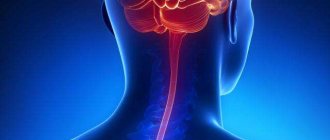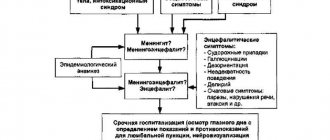Purulent meningitis is an inflammation of the soft membrane of the brain, which is caused by pyogenic microorganisms (meningococci, pneumococci, streptococci, etc.) embedded in it.
The disease can be diagnosed in all age categories of people, but most often in children under the age of five. The development of purulent meningitis is facilitated by a weakened state of the immune system, so the peak of the disease occurs in the winter-spring period.
With purulent meningitis, patients have increased body temperature, intense headache, nausea, vomiting, disorders of the cranial nerves, early appearance of meningeal syndrome, hyperesthesia, disturbance of consciousness, and psychomotor agitation.
Thanks to the development of modern medicine, today the incidence of purulent meningitis has decreased significantly, the number of severe complications and deaths has decreased.
Services for the diagnosis and treatment of meningitis are offered by the neurology clinic of the Yusupov Hospital, a leading multidisciplinary medical center in Moscow. Thanks to the modern equipment of the clinic, the impressive medical experience of our specialists and the use of the latest technologies, the Yusupov Hospital achieves high efficiency in the treatment of meningitis, including purulent meningitis.
The diagnosis of purulent meningitis in the Yusupov Hospital is based on a typical clinical picture and data from a study of cerebrospinal fluid.
For purulent meningitis, patients at the Yusupov Hospital are required to undergo antibacterial therapy. In addition, the use of decongestants, glucocorticosteroids, tranquilizers, anticonvulsants and other symptomatic treatment is prescribed.
Purulent meningitis in adults and children: causes of development
The development of purulent meningitis is caused not only by meningococcal infection, but also by pneumococci, Haemophilus influenzae and other microorganisms.
Purulent meningitis in children is often associated with infection with streptococci, salmonella, and E. coli. In accordance with the mechanism of penetration of the pathogen into the meninges, meningitis can be primary or secondary. The development of primary purulent meningitis is caused by the hematogenous spread of the pathogen from the pharynx or nasal cavity, where it enters from the outside by contact and airborne droplets.
The occurrence of secondary purulent meningitis is associated with a primary septic focus present in the patient’s body and subsequent penetration of infection into the meninges.
Acute purulent otitis and brain abscess
O.V. Stratieva (From lectures for doctors)
Otogenic intracranial complications arise as a result of the penetration of infection from the ear cavities into the brain cavity. The number of patients with otogenic intracranial complications in relation to the total number of patients with diseases of the middle and inner ear ranges from 1 to 15% and tends to decrease. However, the problem of otogenic intracranial complications remains relevant. Over the past three years, we have operated on more than 30 patients with otogenic intracranial complications. The most common were: thrombosis of the sigmoid and transverse sinuses, epidural abscess of the middle and posterior cranial fossae, perisinous abscess, otogenic meningitis, abscess of the temporal lobe of the brain; cerebellar abscess was observed less frequently. The features of the modern clinical picture of otogenic intracranial complications are characterized by a case from our practice.
Case from practice.
G—a, 68 years old, was admitted to the ENT center with complaints of headache, dizziness, nausea, weakness in the left leg, fever up to 37.5 degrees, and malaise.
It is known that the patient had been ill for a month when pain in the right ear and purulent discharge from the ear suddenly appeared. She treated herself with dry heat. After two weeks, the condition improved. The ear pain and suppuration stopped. However, inadequacy, lethargy and headache appeared in the patient’s behavior, which forced the patient’s relatives to seek advice from an otolaryngologist.
On admission: the patient is conscious. There is no pain behind the ear. The eardrum is dull, there is no perforation, there is no pus. The neurologist found a deviation to the left during the finger-nasal test, and smoothness of the left nasolabial fold. In the fundus there is atherosclerosis of the retinal vessels.
A computed tomography scan of the brain on the right in the temporo-parietal region reveals extensive round formations with a capsule up to 2.1 cm in diameter, a density of 19 to 24 units N, with contrast - up to 65 units N. Additionally, magnetic resonance imaging was performed (Fig. 1 , 2), where a purulent process was established in the right temporal pyramid with a bifocal brain abscess and thrombosis of the cavernous sinus.
Otolaryngologists and neurosurgeons performed two operations: craniotomy with brain decompression, opening and removal of the temporal lobe abscess, and extended mastoidectomy with exposure of the cranial fossae and sinuses of the brain. During the operation, osteomyelitis of the pyramid of the temporal bone, the wall of the auditory canal and the tympanic cavity was discovered. The patient was in intensive care for four days, then underwent rehabilitation at the ENT center for 14 days, and was then discharged home in satisfactory condition.
SUMMARY
Today, in comparison with the period from 1946 to 1980. XX century, the number of intracranial complications due to otitis media decreased significantly. The use of powerful antibiotics has significantly improved the quality of treatment, but at the same time has complicated diagnosis. If previously manifest forms with clear symptoms prevailed, today almost all otogenic intracranial complications develop covertly. Also, in recent years, diagnostic difficulties have been caused by a combination of several forms of intracranial complications.
Purulent meningitis: symptoms
The duration of the incubation period for primary purulent meningitis is, on average, from two to five days. The disease has an abrupt onset. Patients experience increased body temperature, which can reach 40°C, intense and worsening headache, severe chills, nausea and repeated vomiting. The appearance of delirium, psychomotor agitation, confusion, and convulsive syndrome may occur.
Purulent meningitis in adults and children is accompanied by specific symptoms (Brudzinsky, Kernig, Guillain, stiff neck), which occur at an early stage of the disease and intensify after 2-3 days. Patients exhibit severe hyperesthesia and decreased abdominal reflexes, while deep reflexes are increased. In some cases, a diffuse hemorrhagic rash appears.
With purulent meningitis, patients experience double vision, strabismus, drooping of the upper eyelid, and anisocoria, which is associated with damage to the oculomotor nerves.
In more rare cases, there is damage to the trigeminal nerve, the development of neuritis of the facial nerve, dysfunction of the vestibulocochlear (progressive development of hearing loss) and optic nerve (decreased visual acuity, loss of visual fields).
If the inflammatory process spreads to brain tissue, patients develop meningoencephalitis.
Secondary purulent meningitis
For purulent meningitis, treatment should be quick and clear. In most cases, the patient should be isolated. Specific therapy and symptomatic treatment are prescribed, and general measures are carried out. Patient care is the same as for other acute infections. If the patient is restless or has insomnia, phenobarbital or tranquilizers should be prescribed. It is advisable to avoid morphine and similar substances. For headaches, analgesics are prescribed. Sibazone and phenobarbital should be used to prevent seizures, which are rare in adults but common in children with meningitis. Blood transfusions are indicated when severe anemia develops due to infection or certain medications. The use of corticosteroids is indicated for severe forms of meningitis. It is important to monitor adequate water balance, bowel and bladder functions, and prevent bedsores. Hyponatremia may predispose to both seizures and decreased response to treatment. When the cause of the development of purulent meningitis is a nearby purulent focus, surgical intervention is necessary. Treatment of the consequences of purulent meningitis involves the elimination of convulsions, physical methods, restorative measures, and sometimes surgical intervention for arachnoiditis, hydrocephalus, and subdural hemorrhages. Increased intracranial pressure is observed in almost all cases of purulent meningitis. It is an early symptom and improves with adequate therapy. It is advisable to use hypertonic solutions, for example mannitol (at a dose of 25 g in 250 ml of 5% glucose solution for 1–2 hours). Corticosteroids are prescribed for increased intracranial pressure. Adult dosage: 8–12 mg dexamethasone IV, then 4 mg IM every 6 hours. Dexamethasone can be administered IV at a dose of 4–8 mg every 6–8 hours for an extended period. An important factor in reducing intracranial pressure is ensuring patency of the airways, frequent suction of mucus and sputum from the respiratory tract in those in serious condition. Tracheostomy should not be delayed in the hope that antimicrobial therapy will improve respiratory distress. Monitoring blood gases will provide earlier information about oxygen deprivation and allow the necessary treatment to be prescribed.
Patients in a state of deep coma are given a nasogastric tube. Hyperthermia should be vigorously combated, especially in children.
Specific treatment. The introduction of sulfonamides and antibiotics into practice dramatically changed the outcome of the disease, which previously had always been fatal.
The effectiveness of specific measures depends on early identification of the microorganism and treatment of it by prescribing adequate doses of drugs. Intensive treatment should be carried out using drugs that are as low-toxic as possible. The clinical condition usually improves within 10 days to 2 weeks from the onset of symptoms if treated early and vigorously. When establishing the meningococcal, pneumococcal and streptococcal etiology of meningitis, penicillin is most effective in a dose for an adult of 24,000,000–32,000,000 units per day (at least 300,000 units per 1 kg of body weight), administered intramuscularly in 6–8 doses. The duration of treatment is determined by the course of the disease (on average 7–10 days). Treatment can be stopped when there is a clear general improvement: restoration of consciousness, normalization of temperature and the number of leukocytes in the blood.
Along with clinical indicators, the main criterion for reducing the dose or discontinuing the drug is the sanitation of the cerebrospinal fluid: a decrease in the number of cells to less than 100 in 1 μl with a lymphocyte content of at least 75%. In severe forms of purulent meningoencephalitis, the daily dose of penicillin administered intramuscularly should reach 48,000,000 units per day. In case of coma and in cases of delayed initiation of treatment, the dose of penicillin administered intramuscularly is increased to 800,000–1,000,000 units per 1 kg of body weight per day; In addition, intravenous administration of sodium (!) salt of benzylpenicillin is recommended at 4,000,000–12,000,000 units per day.
For meningitis caused by E. coli, morphocycline, chloramphenicol hemisuccinate (chloramphenicol), and kanamycin are prescribed.
When infected with Pseudomonas aeruginosa, polymyxin-M is used. For influenza meningitis, the drug of choice is chloramphenicol hemisuccinate (chloramphenicol).
Semi-synthetic penicillins are also used to treat purulent meningitis. Ampicillin is prescribed at a rate of 200–300 mg/kg per day with six injections intramuscularly and intravenously.
Cephalosporins (zeporin or cephaloridin) are effective against the same microorganisms as penicillin, as well as penicillinase-forming strains of staphylococcus and can be used for allergies to penicillins. Administer intramuscularly or intravenously to children at 60 mg/kg per day, to adults at 1 g every 6 hours.
For staphylococcal meningitis, ceporin (cephaloridine), oleandomycin, and olemorphocycline are administered endolumbarally.
Levomycetin succinate soluble (broad-spectrum antibiotic) is administered parenterally at a dose of up to 100 mg/kg 3-4 times a day.
Long-acting sulfonamides (sulfamonethoxine, sulfapyridazine, sulfadimethoxine) are known to be highly effective.
These drugs are prescribed orally according to the following regimen: on the 1st day, 2 g 2 times, on subsequent days - 2 g 1 time per day. However, they can only be used in the absence of vomiting and disturbances of consciousness.
Intramuscular administration of penicillin for fulminant forms of purulent meningitis should be supplemented with intravenous administration of antibiotics. Intramuscular administration is ineffective in the acute stage of infectious-toxic shock, with low blood pressure and slow blood flow. In these cases, intravenous infusion of the antibiotic is necessary to create conditions for its maximum diffusion into the affected tissues.
Start-up therapy for purulent meningitis of unknown etiology is the intramuscular administration of aminoglycoside antibiotics (kanamycin, gentamicin) at a dose of 2 to 4 mg/kg or a daily dose of 0.5 mg/kg or ampicillin in combination with kanamycin. The use of penicillin together with antibiotics - synergists of bactericidal action (gentamicin and kanamycin) is indicated. It is possible to combine gentamicin with ampicillin (50–100 mg/kg per day, the dose is divided and administered every 12 hours).
Nonspecific treatment. It is extremely important to promptly treat cerebral edema using diuretics and corticosteroids. Corticosteroid therapy is more effective the earlier it is prescribed. Dexamethasone is most often used intravenously.
In case of hypovolemia, intravenous drip administration of isotonic glucose-saline solutions (0.9% sodium chloride solution, 5% glucose solution, Ringer's solution) is necessary. To correct the acid-base state in order to combat acidosis, a 4-5% sodium bicarbonate solution (up to 800 ml) is prescribed intravenously. For the purpose of detoxification, plasma-substituting solutions that bind toxins circulating in the blood are injected intravenously. Hemodez is heated to 35 °C and 300–500 ml is infused at a rate of 40–80 drops per minute (250–500 ml per injection), rheopolyglucin – up to 1000 ml. Such infusion-detoxification therapy must be carried out in combination with forced diuresis. At least 3 g of potassium chloride per day should be administered (100 ml of a 3% potassium chloride solution, 400 ml of a 10% glucose solution and 15 units of insulin are added to the dropper).
To relieve convulsions and psychomotor agitation, seduxen is prescribed intravenously (4–6 ml of 0.5% solution), lytic mixtures (2 ml of 2.5% solution of aminazine, 1 ml of 1% solution of promedol, 1 ml of 1% solution of diphenhydramine) are administered intramuscularly until 3–4 times a day.
In case of infectious-toxic shock with symptoms of acute adrenal insufficiency, intravenous infusion of fluids is performed (a mixture of isotonic sodium chloride solution with 10% glucose solution, polyglucin, blood plasma). To the first portion of liquid (500–1000 ml) add 125–500 mg of hydrocortisone or 30–50 mg of prednisolone, or 5–10 mg of cortin, as well as 500–1000 mg of ascorbic acid, cordiamin, strophanthin.
If the acute phase of meningitis has passed, then general restoratives are indicated: glutamic acid, multivitamins, as well as metabolic drugs: aminalon, piracetam (nootropil), pyriditol (encephabol) and pantogam. Typically, such treatment is prescribed in the presence of asthenic syndrome.
Mortality from meningitis has fallen significantly over the past two decades, but many patients die or remain disabled because diagnosis or treatment is delayed. Timely diagnosis and intensive therapy are necessary. Lumbar puncture should not be delayed when meningeal symptoms and unexplained fever are present. Even with a timely puncture, incomplete examination of the cerebrospinal fluid can make it difficult to make a correct diagnosis. The following factors are important in determining the prognosis: “the causative agent of the infection, age (in the elderly), time of year, severity of the disease at the time of hospitalization, the presence of predisposing and concomitant diseases. For meningococcal, pneumococcal and influenza meningitis, antigen determination in serum and cerebrospinal fluid can also be used. The antigen usually disappears from it within 24 to 48 hours: longer persistence of the antigen indicates a poor prognosis.
Purulent meningitis: consequences in adults
One of the early and serious complications of purulent meningitis is cerebral edema, as a result of which the brain stem and vital centers located in it are compressed. The development of acute cerebral edema occurs on days 2-3 of the disease, but in the fulminant form - within the first few hours.
In addition to cerebral edema, patients may experience the development of septic shock, subdural empyema, adrenal insufficiency, infective endocarditis, pneumonia, purulent arthritis, pyelonephritis, cystitis, septic panophthalmitis, etc.
Etiological information
The most common pathogen is the coccal form of microorganisms.
However, it is not possible to detect any microflora in the cerebrospinal fluid (CSF).
Often, an infectious agent spreads through contact or labyrinthogenic means. In the first option, there are pronounced transformations up to the destruction of the bone structures separating the middle ear from the cerebral membranes.
In the case of labyrinthogenic genesis, the infection from the labyrinth penetrates through the cochlear aqueducts, vestibules and internal auricular meatus. This method of penetration of an infectious agent is observed much more often in comparison with other intracranial complications.
The pathology develops mainly against the background of mastoiditis, which complicates acute purulent otitis media, and chronic purulent otitis (epitympanitis), especially if it is complicated by cholesteatoma.
In the initial period of acute otitis, leptomeningitis is often the result of hematogenous generalization of the infection (through the blood vessels). This is the lightning-fast form, which is the most unfavorable.
Purulent meningitis: diagnosis
Experienced neurologists at the Yusupov Hospital can assume the presence of purulent meningitis if the patient has meningeal syndrome and focal neurological symptoms in the form of damage to the cranial nerves.
In case of abortive course of purulent meningitis or its secondary occurrence against the background of symptoms of an existing septic focus of another localization, diagnosis is more difficult and requires a lumbar puncture with subsequent detection of increased cerebrospinal fluid pressure, its turbidity or opalescent color.
When performing a study of cerebrospinal fluid in patients with purulent meningitis, an increased level of cellular elements and protein is determined.
In order to identify the type of causative agent of the disease, the Yusupov Hospital conducts a microscopic examination of smears of cerebrospinal fluid and its inoculation on nutrient media.
During the diagnosis, a study of the discharge elements of the skin rash and a blood test are carried out.
If the secondary nature of purulent meningitis is suspected, additional studies are prescribed to determine the primary infectious focus:
- consultations with a pulmonologist, otolaryngologist, therapist and other specialists;
- otoscopy;
- X-ray of the lungs and paranasal sinuses.
During diagnosis, specialists at the Yusupov Hospital differentiate purulent meningitis from viral meningitis, subarachnoid hemorrhage, meningeal phenomena in other infections (severe forms of influenza, typhus, leptospirosis, etc.).
Purulent meningitis in newborns
Purulent meningitis in newborns is an inflammation of the meninges, a serious disease that occupies one of the first places among infectious diseases of the central nervous system in young children. The incidence of purulent meningitis is 1-5 per 10 thousand newborns.
It can result in death or disabling complications (hydrocephalus, blindness, deafness, spastic paresis and paralysis, epilepsy, delayed psychomotor development up to mental retardation). The outcome depends on timely initiation of intensive treatment. Etiology and pathogenesis.
According to etiology, meningitis is divided into viral, bacterial and fungal. The route of infection is hematogenous. Infection of a child can occur in utero, including during childbirth or postnatally. The sources of infection are the mother's genitourinary tract; infection can also occur from a patient or from a carrier of pathogenic microflora. The development of meningitis is usually preceded by hematogenous spread of infection. Microorganisms overcome the blood-brain barrier and penetrate the central nervous system. Predisposing factors are infections of the maternal urogenital tract, chorioamnionitis, a long anhydrous period (over 2 hours), intrauterine infection, prematurity, intrauterine malnutrition of the fetus and its morphofunctional immaturity, asphyxia of the fetus and newborn, intracranial birth trauma and related therapeutic measures, malformations of the central nervous system. and other situations when there is a decrease in immunological protective factors. The penetration of a bacterial infection into the child’s bloodstream is facilitated by inflammatory changes in the mucous membrane of the nose and pharynx during an acute respiratory viral infection, which, according to our observations, often accompanies the onset of purulent meningitis.
Meningitis is now often caused by Streptococcus agalactiae (group B beta-hemolytic streptococcus) and Escherichia coli. The meningococcal etiology of purulent meningitis in newborns is now rarely observed, which is apparently explained by the passage of immunoglobulin G, containing antibodies to meningococcus, through the mother's placenta to the fetus. Intrauterine meningitis, as a rule, clinically manifests itself in the first 48-72 hours after birth, postnatal meningitis manifests itself later. According to our data, such children were admitted to the clinic on the 20-22nd day of life, when there is a decrease in the content of immunoglobulin G received from the mother in the newborn’s blood serum. By this time, maternal immunoglobulin G is catabolized and its level in the blood decreases by 2 times.
Postnatal meningitis can also develop in intensive care units and in departments for nursing premature babies. Their main pathogens are Klebsiella spp., Staphylococcus aureus, P. aeroginosae and fungi of the genus Candida. As our observations have shown, the mothers' anamnesis included risk factors such as threatened miscarriage, urinary tract infection, the presence of chronic foci of infection in pregnant women (tonsillitis, sinusitis, adnexitis, vaginal thrush), as well as a long anhydrous interval during childbirth (from 7 to 28 hours).
Despite the variety of pathogens causing purulent meningitis in newborns, the morphological changes in the central nervous system are similar. They are localized mainly in the soft and arachnoid membranes. Removal of exudate occurs by phagocytosis of fibrin and necrotic cells by macrophages. In some, it undergoes organization, which is accompanied by the development of adhesions. Impaired patency of the cerebrospinal fluid pathways can lead to the development of occlusive hydrocephalus. Reparation may take 2-4 weeks or more.
Clinic and diagnostics
There are difficulties in diagnosing purulent meningitis both at home and when a child is admitted to the hospital, since clear clinical manifestations develop later, and at first nonspecific symptoms are observed, similar to many infectious and inflammatory diseases (pallor, marbling, cyanosis of the skin, conjugation jaundice, hyperesthesia , vomit). Some children experience an increase in temperature to low-grade levels. Symptoms of the disease develop gradually. The child's condition is progressively deteriorating. The temperature rises to 38.5-39°C. On examination, the skin is pale, sometimes with a grayish tint, acrocyanosis and marbling are often noted, and sometimes conjugative jaundice is expressed in children. There are disturbances from the respiratory system - a decrease in respiratory rate, attacks of apnea, and bradycardia is characteristic of the cardiovascular system. Patients also have hepato- and splenomegaly.
In the neurological status of some newborns, signs of central nervous system depression are observed: lethargy, drowsiness, adynamia, decreased physiological reflexes, muscle hypotension. Others experience symptoms of central nervous system excitation: motor restlessness, hyperesthesia, painful and high-pitched cry, tremor of the chin and limbs, foot clonus. Disorders of the cranial nerves can manifest themselves in the form of nystagmus, floating movements of the eyeballs, strabismus, and the “setting sun” symptom. Some babies experience regurgitation and repeated vomiting, weak sucking, or refusal of the breast and pacifier. A sick child does not gain weight well. At a later stage, tilting of the head back and meningeal symptoms (tension and bulging of the large fontanel, rigidity of the muscles of the back of the neck) appear. A typical position is for a child to lie on his side with his head thrown back, legs bent and pressed to his stomach. Meningeal symptoms, typical for older children (Kernig, Brudzinsky), are uncharacteristic for newborns. Sometimes a positive Lessage symptom is observed: the child is lifted up by the armpits, and at this time his legs are in a flexed position. Polymorphic convulsions, paresis of cranial nerves, and changes in muscle tone may be observed. The cause of the development of seizures is hypoxia, microcirculatory disorders, cerebral edema, and sometimes hemorrhagic manifestations. In some cases, there is a rapidly progressive increase in head circumference and divergence of cranial sutures due to intracranial hypertension.
An analysis of the medical records of newborns with purulent meningitis who were in our clinic revealed that all of them were admitted at the age of 7 to 28 days of life (average age - 23 days). When referred to the hospital, purulent meningitis was suspected in only 2 children; in the rest, the referring diagnosis was ARVI, enterocolitis, conjugation jaundice, intrauterine infection, urinary tract infection, and osteomyelitis. On admission, the majority of newborns did not have clear and characteristic signs of meningitis. However, the anamnestic data and serious condition suggested that the disease began earlier, which was confirmed by studies of the cerebrospinal fluid. Upon admission, most children had an increase in temperature to 38-39.6 ° C. As a rule, there were no pronounced catarrhal symptoms. In some children, the clinical picture showed manifestations of local purulent infection (purulent conjunctivitis, omphalitis, urinary tract infection).
In the blood test, most children showed inflammatory changes in the form of an increase in the number of leukocytes (13-34.5x109/l) with a significant increase in the number of band neutrophils up to the appearance of juvenile forms, as well as an increase in ESR up to 50 mm/hour.
Changes in urine tests (leukocyturia) were observed in three children with a combination of purulent meningitis and pyelonephritis.
To confirm the diagnosis, lumbar puncture should be performed at the slightest suspicion of meningitis, in the early stages, without waiting for the development of its full-blown clinical picture. In cases where for some reason it is not possible to perform a lumbar puncture, one should focus on the clinical picture of the disease. During lumbar puncture for purulent meningitis in newborns, cerebrospinal fluid often flows out under pressure, is cloudy, and sometimes, with large cytosis, yellow in color and thick. Shock and disseminated intravascular coagulation are contraindications to lumbar puncture.
In our observations, almost all admitted children were diagnosed on the first day of hospital stay. Indications for urgent lumbar puncture were the presence of febrile temperature (above 38°C), symptoms of infectious toxicosis without a visible focus of bacterial infection, and less commonly, hyperesthesia. In the cerebrospinal fluid there was an increase in the content of leukocytes with a predominance of the neutrophilic component (more than 60%).
With purulent meningitis, the content of total protein in the cerebrospinal fluid increases later than the increase in neutrophilic pleocytosis. The protein content increases from the onset of the disease and can serve as an indicator of the duration of the pathological process. In our studies, protein concentration ranged from 0.33 0/00 to 9 0/00. An increased protein content in the cerebrospinal fluid obtained during the first puncture was found in 10 patients, which indicated a certain duration of the disease. Purulent meningitis is characterized by low levels of glucose in the cerebrospinal fluid.
In order to identify the pathogen and determine its sensitivity to antibiotics, a microbiological study of the cerebrospinal fluid is carried out. In our observations, clinical and laboratory data indicated the purulent nature of meningitis, while culture of the cerebrospinal fluid and smear bacterioscopy in most cases did not reveal the pathogen. Group B beta-hemolytic streptococcus was detected in two patients, Haemophilus influenzae was cultured in one, and pneumococcus was cultured in one.
Viral meningitis is characterized by serous inflammation of the meninges with an increase in the content of lymphocytes in the cerebrospinal fluid. Serous meningitis has a milder course.
Instrumental methods include ultrasound examination of the brain (neurosonography) and computed tomography, which are performed according to indications.
Neurosonography allows you to diagnose ventriculitis, dilation of the ventricular system, the development of a brain abscess, as well as identify severe concomitant intracranial hemorrhages, ischemic infarctions, and developmental defects.
Computed tomography is indicated to exclude brain abscess, subdural effusion, as well as to identify areas of thrombosis, infarction and hemorrhage in brain structures.
Complications
The most common early complications are cerebral edema and swelling and seizures.
Clinically, cerebral edema is manifested by increasing intracranial hypertension. During this period, the newborn's posture with his head thrown back is characteristic; there is a monotonous, at times piercing, cry, sometimes turning into a groan. Possible bulging of the large fontanel, its pulsation, and separation of the cranial sutures. Brain edema can be clinically manifested by dysfunction of the oculomotor, facial, trigeminal and hypoglossal nerves. Coma is clinically manifested by inhibition of all types of cerebral activity: adynamia, areflexia and diffuse muscle hypotonia. Further, the pupillary response to light disappears, apnea attacks become more frequent, and bradycardia develops.
With purulent meningitis, convulsive syndrome often develops. Initially, the seizures are clonic in nature, and as cerebral edema progresses, they transform into tonic ones.
A very dangerous complication of meningitis is bacterial (septic) shock. Its development is associated with the penetration of a large number of bacterial endotoxins into the bloodstream. Clinically, septic shock is manifested by sudden cyanosis of the extremities, a catastrophic decrease in blood pressure, tachycardia, shortness of breath, a weak moaning cry, loss of consciousness, often in combination with disseminated intravascular coagulation syndrome. Among the newborns we observed, two children died. One girl was admitted on the 11th day of life and died in the first 6 hours of hospital stay from infectious-toxic shock complicated by disseminated intravascular coagulation. The second girl, 17 days old, died on the 2nd day after admission. She had an intrauterine generalized cytomegalovirus infection and developed purulent meningitis. Severe consequences of purulent meningitis can include hydrocephalus, blindness, deafness, spastic paresis and paralysis, mental retardation, and epilepsy.
Differential diagnosis
Neurological symptoms similar to purulent meningitis can be observed in the presence of intracranial hemorrhage in a newborn. Such children also experience motor restlessness, tremor of the chin and limbs, nystagmus, strabismus, and the “setting sun” symptom. To exclude purulent meningitis, a spinal puncture is necessary. Intraventricular hemorrhage is characterized by the presence of a large number of altered erythrocytes in the cerebrospinal fluid, as well as an increased concentration of total protein in the cerebrospinal fluid from the first days of the disease due to the penetration of plasma proteins and lysis of erythrocytes.
Often purulent meningitis occurs with vomiting, so it is necessary to carry out a differential diagnosis with pyloric stenosis, in which “fountain” vomiting is observed without fever and inflammatory changes in the blood test. Often, when examining the abdomen, a positive hourglass sign is noted. The main methods for diagnosing pyloric stenosis are esophagogastroduodenoscopy and ultrasound.
Symptoms of central nervous system excitation (restlessness, tremor of the limbs and chin, hyperesthesia), similar to purulent meningitis, can be observed with influenza and ARVI. In this case, meningism occurs - a condition characterized by the presence of clinical and cerebral symptoms without inflammatory changes in the cerebrospinal fluid. Meningism is not caused by inflammation of the meninges, but by their toxic irritation and increased intracranial pressure. During a spinal puncture, the fluid is clear and colorless, flows out under increased pressure, often in a stream, but the content of cells, protein, and glucose is normal. Meningismus usually manifests itself in the acute period of the disease and often precedes inflammation of the meninges, which can develop within a few hours after its detection. If meningeal symptoms of influenza and ARVI do not disappear, or, moreover, increase, repeated diagnostic spinal punctures are necessary.
Purulent meningitis can occur in a child with sepsis, which significantly complicates the clinical picture of the disease.
Treatment
Newborns with purulent meningitis require complex treatment, including antibacterial, infusion therapy, and immunoglobulin replacement therapy for intravenous administration. If necessary, hormonal, anticonvulsant, and dehydration therapy is carried out. Such children require the most gentle regimen. In the acute period, it is not recommended to breastfeed them. They receive expressed mother's milk, or, if the mother does not have it, formula from a bottle. When the sucking reflex is suppressed, feeding the child through a tube is used.
Causal antibacterial therapy is the main method of treating newborns with purulent meningitis. It is carried out taking into account the pathogen isolated from the cerebrospinal fluid and its sensitivity to antibiotics. If the pathogen has not been found, the effectiveness of antibacterial therapy is assessed based on clinical data and the results of a repeat examination of the cerebrospinal fluid no later than 48-72 hours from the start of treatment. If during this time there is no obvious clinical and laboratory improvement, the antibacterial treatment is changed. In newborns with purulent meningitis, antibiotics should be administered intravenously three or four times in the maximum allowable doses through a subclavian catheter.
Antibiotics are used that penetrate the blood-brain barrier and have a wide spectrum of antimicrobial action. A combination course of antibacterial therapy usually includes third-generation cephalosporins (ceftazidime, ceftriaxone) and an aminoglycoside (amikacin, netilmicin, gentamicin). All children we treated were prescribed antibacterial therapy immediately upon admission to the hospital and included a cephalosporin. After receiving the result of the lumbar puncture, a second aminoglycoside antibiotic was added to the combination antibacterial therapy regimen. If a second course of antibiotics was necessary, when it was not possible to achieve improvement in the patient's condition and normalization of cytosis in the cerebrospinal fluid, the children received a second course of antibacterial therapy with meropenem and vancomycin.
The issue of hormone therapy was decided individually, taking into account the severity of the condition. In severe cases of purulent meningitis, hormonal therapy in the acute period of the disease led to an earlier disappearance of fever and intoxication, and an improvement in the condition of the newborn.
To treat hypertensive-hydrocephalic syndrome, dehydration was performed using furosemide. Subsequently, after the elimination of the symptoms of infectious toxicosis, in the presence of intracranial hypertension, acetazolamide was prescribed according to the regimen.
As our observations have shown, a good effect is achieved by including immunoglobulin for intravenous administration in the treatment regimen in order to increase the body’s defenses, which is especially effective in the early stages of the disease. Immediately after diagnosis, all patients began intravenous immunoglobulin administration. It was administered 2 to 5 times with mandatory laboratory monitoring (determination of immunoglobulins G, M and A) before and after administration. More frequent administration was required by children who showed slow positive dynamics of clinical and laboratory symptoms.
Viferon suppositories containing recombinant human leukocyte interferon alpha-2b were added later, after clinical and laboratory parameters improved. It was administered at a dose of 150,000 IU 2 times a day, the course duration was 10 days.
Simultaneously with the start of antibacterial therapy in children, intensive infusion therapy was started through a subclavian catheter, including transfusion of solutions of glucose, rheopolyglucin, vitamins (C, B6, cocarboxylase), furosemide, antihistamines for the purpose of detoxification, improvement of microcirculation, and correction of metabolic disorders.
Diazepam was used to relieve convulsive syndrome. Phenobarbital was prescribed for maintenance anticonvulsant therapy. Drugs that improve cerebral circulation (vinpocetine, cinnarizine, pentoxifylline) were also used.
The average stay of patients in the clinic was 26 days (from 14 to 48 days).
Prognosis and long-term consequences
Purulent meningitis in newborns is a serious disease, the mortality rate of which remains high.
As our studies have shown, complex intensive therapy for purulent meningitis in newborns, started at the earliest stage of the disease, gives good results. Observation for 1-3 years of children who suffered purulent meningitis in the neonatal period showed that in most of them, with early detection of the disease and adequate treatment, psychomotor development corresponds to their age. However, two children developed progressive hydrocephalus, four had muscle tone disorders and subcompensated hypertensive-hydrocephalic syndrome.
Children who have suffered purulent meningitis during the neonatal period should be observed by a pediatrician and neurologist.
Oleg BOTVINYEV, Head of the Department of Pediatrics, Faculty of Postgraduate Education, MMA named after. I.M. Sechenov.
Irina RAZUMOVSKAYA, associate professor.
Vera DORONINA, graduate student.
Alla SHALNEVA, head of the neonatal department of Children's City Clinical Hospital No. 9 named after. G.N. Speransky Moscow.
Signs and symptoms of disease development
The latent period lasts from three to five days, depending on the general condition of the body, the entrance gate of the infection, the form of the disease and the pathogen. The first symptoms of purulent meningitis in children include fever, dizziness and headaches; nausea and vomiting may occur , which does not bring relief to the child.
At the peak of the temperature, various disturbances of consciousness develop - lethargy, hallucinations, delusional states. Rigidity of the neck muscles develops when the child cannot bring his head to his chest.
Features of the clinical picture of inflammation of the meninges in children:
- bulging, retraction or pulsation of the large fontanelle (for young children);
- characteristic pose: head thrown back and legs pressed to the stomach;
- anxiety, sleep disturbance;
- refusal to eat;
- symptoms typical for any form of meningitis - Lessage (pulling the legs to the stomach in a suspended state), Meitus (the child cannot sit up independently in bed due to the inability to straighten the legs at the knees);
- spasms of large muscles and facial muscles;
- increased sensitivity to light and loud sounds;
- hemorrhagic rashes predominantly localized on the thighs and buttocks.
Important! When the first symptoms of meningitis appear, you must immediately consult a doctor or call an ambulance!
Consequences of purulent meningitis
The consequences of this disease in children include:
edema and swelling of the brain matter with the development of wedging of the brain into the foramen magnum of the base of the skull;- septic complications;
- multiple organ failure;
- development of endocarditis;
- empyema of the dura mater;
- development of sensorineural hearing loss;
- epileptic syndrome;
- coma and death.









